
About UsThe Numismatic Bibliomania Society is a non-profit organization promoting numismatic literature. For more information please see our web site at coinbooks.org SubscriptionsThose wishing to become new E-Sylum subscribers (or wishing to Unsubscribe) can go to the following web page link MembershipThere is a membership application available on the web site Membership Application To join, print the application and return it with your check to the address printed on the application. Membership is only $15 to addresses in the U.S., $20 for First Class mail, and $25 elsewhere. For those without web access, write to: David M. Sundman, Secretary/TreasurerNumismatic Bibliomania
Society AsylumFor Asylum mailing address changes and other membership questions, contact David at this email address: dsundman@LittletonCoin.com SubmissionsTo submit items for publication in The E-Sylum, just Reply to this message, or write to the Editor at this address: whomren@coinlibrary.com
BUY THE BOOK BEFORE THE COINYou won't regret it! |
- WAYNE'S WORDS: THE E-SYLUM FEBRUARY 17, 2013
- KOLBE & FANNING NUMISMATIC EPHEMERA SALE #1 RESULTS
- NEW BOOK: THE INGLE SYSTEM SCRIP OF THE MID-ATLANTIC REGION
- NEW BOOK: COINS OF THE HOLY LAND
- NEW BOOK: THE HIGHEST PERFECTION: A HISTORY OF DE LA RUE
- NEW BOOKS: MONETA PUBLICATIONS 151 AND 152
- BOOK REVIEW: THE UNIFORM COINAGE OF INDIA 1835 – 1947
- ANS LIBRARY WISHLIST UPDATED
- TAMS LITERARY AWARD NOMINATIONS SOUGHT
- NOTES FROM E-SYLUM READERS: FEBRUARY 17, 2013
- NEW YORK PUBLIC LIBRARY COLONIAL ERA ARCHIVE
- ARTICLE HIGHLIGHTS 1794 DOLLAR RESEARCH EFFORTS
- THE LIFE AND COINS OF GEORGE T. MORGAN
- WAYNE'S NUMISMATIC DIARY: FEBRUARY 17, 2013
- MORE ON THE ERIC NEWMAN COLLECTION SALES
- QUERY: WHERE IS THE RUTH HILL WORLD PAPER MONEY COLLECTION?
- WEB RESOURCES FOR NUMISMATIC WRITERS
- B. MAX MEHL'S 'A ROYAL SALE'
- WAYTE RAYMOND'S "COIN TREE" HOLDER IMAGES SOUGHT
- WORLD COIN EXPERT POSITION OPEN AT HARLAN J. BERK LTD.
- U.S. COIN BUYING GUIDE HISTORY
- JOHN HUFFMAN AND GORDON FROST
- GROVER CRISWELL'S CONGRESSIONAL TESTIMONY ON GOLD OWNERSHIP
- MILITARY PAYMENT CERTIFICATE DESIGNER LEONARD BUCKLEY
- PERIODICAL: MÜNZEN & SAMMELN
- THE DISTINGUISHED WARFARE MEDAL
- VATICAN SEDE VACANTE: POPE BENEDICT XVI RESIGNS
- MELTED CANADIAN POLYMER NOTES
- PURPLE HEART, OTHER MEDALS REUNITED WITH FAMILY
- VIDEO: COIN ROLLING ON TREADMILL
- FEATURED WEB PAGE: NATION OF CELESTIAL SPACE
WAYNE'S WORDS: THE E-SYLUM FEBRUARY 17, 2013

Many thanks and a warm welcome to our new advertisers this week - John Kraljevich Americana and Harlan J. Berk Ltd. Also, Stack's-Bowers is back with a display ad for their upcoming auction. Thanks to all of our advertisers for their support. Please support them in turn - check out their web sites and consider buying, selling or responding if there is a match for your interests.
We have no new subscribers this week. Please pass the word to your friends. We have 1,625 email subscribers, plus 212 followers on Facebook.
This week we open with an update from Kolbe & Fanning, announcements of five new numismatic books, and my review of The Uniform Coinage of India 1835 – 1947.
Other topics include the ANS Library, the Eric P. Newman Numismatic Education Society coin sales, web resources for numismatic researchers, War of 1812 silver medals, Grover Criswell's Congressional testimony, and Wayte Raymond's Coin Tree holder.
To learn more about Münzen & Sammeln, the Ingle System scrip of the Mid-Atlantic Region, the Ruth Hill world paper money collection, Max Mehl's "Royal Sale", Vlad the Impaler, the Nation of Celestial Space and turban-wearing Canadian Mounties, read on. Have a great week, everyone!
Wayne Homren
Editor, The E-Sylum
KOLBE & FANNING NUMISMATIC EPHEMERA SALE #1 RESULTS
 Kolbe & Fanning are pleased to announce the successful completion of our first internet sale of numismatic ephemera. The sale, which included a diverse offering of numismatic memorabilia, letters, circulars, photos, promotional materials and other miscellanea, was enthusiastically received and brought 135% of the total estimated value of the lots.
Kolbe & Fanning are pleased to announce the successful completion of our first internet sale of numismatic ephemera. The sale, which included a diverse offering of numismatic memorabilia, letters, circulars, photos, promotional materials and other miscellanea, was enthusiastically received and brought 135% of the total estimated value of the lots.
The recently completed sale is the first of a projected series of internet sales of numismatic ephemera collected over the years by the firm’s founder, George F. Kolbe. It is anticipated that each sale will feature 100 lots, which will be posted on the firm’s website at www.numislit.com on a regular basis. We expect to hold the second sale sometime in March.
A few of the highlights in the first sale follow:
—A letter from Eliasberg to Mehl about the 1804 dollar brought $375
—A letter from B. Max Mehl to George Sexton, Jr. on CSA currency brought $325
—An early offering of Confederate stamps, notes & bonds brought $160
—Various promotional circulars issued by Lyman Low sold for between $70 and $225
—Frank Norton’s resignation notice from the AJN brought $220
We thank everyone who participated and look forward to next time.
To visit the Kolbe & Fanning web site, see: www.numislit.com
NEW BOOK: THE INGLE SYSTEM SCRIP OF THE MID-ATLANTIC REGION
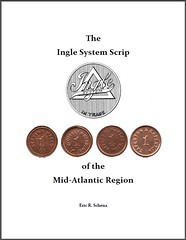 As several E-Sylum regulars know, I have been working on a book on Ingle tokens, The Ingle System Scrip of the Mid-Atlantic Region. The book is back from the printers and will soon be available through the Virginia Numismatic Association. The 8 1/2 x 11 paperback is heavily illustrated in full color throughout and is 165 pages in length. It includes county distribution maps of where the tokens were used in the region.
As several E-Sylum regulars know, I have been working on a book on Ingle tokens, The Ingle System Scrip of the Mid-Atlantic Region. The book is back from the printers and will soon be available through the Virginia Numismatic Association. The 8 1/2 x 11 paperback is heavily illustrated in full color throughout and is 165 pages in length. It includes county distribution maps of where the tokens were used in the region.
This book was born out of frustration trying to get tangible attributions on Ingle tokens. Until recently, identifying where a given Ingle System token was used was problematic at best. Unfortunately for collectors, a large number of Ingle System scrip does not indicate place of use and some tokens have generic names, further frustrating would-be identification. The Ingle System tokens were the first of the “system” style tokens – tokens that used a standard format and sometimes used a special register. System scrip became especially popular with coal mines, where keeping track of advances on pay envelopes was especially crucial.
With the generous help of John Byars (whom I met through The E-Sylum) and Dave Schenkman, I was able to go through much of the remaining Ingle records and help piece together information on Ingle System tokens used in the central Mid-Atlantic States of Virginia, West Virginia, Maryland, and the District of Columbia (at this time, no Ingle tokens are known from Delaware).
The Ingle System Scrip of the Mid-Atlantic Region correlates data from the Ingle ledgers, published and unpublished information regarding denominations, and design types gathered from various sources. It covers the 419 confirmed attributions to the region: 290 merchants from WV, 116 from VA, 12 from MD, and 1 from DC. It also includes a section on Ingle tokens that were attributed to the region through Lloyd Wagaman's groundbreaking effort in the 1980s but have since been reattributed through the ledgers. To help pinpoint a particular issuer, there are two indexes, one by merchant name and one by location.
I know copies will be available at the Salem, VA and Winchester, VA coin shows and I believe the final selling price should be in the $25 range, though I am not positive of that price.
I got a copy from Eric on Tuesday. The book is perfect bound with white covers, and has color illustrations throughout. I was pleased to see the full-page illustration of a three-drawer Ingle System Register on p5 - I'd never seen one of these and wasn't aware they existed. The color-coded maps of Maryland, Virginia and West Virginia counties are a helpful addition (the colors signify the number of known Ingle scrip merchants in each area, and help readers locate issuers geographically.
Eric has clearly done the token hobby a great service with this publication. Through his research and by consulting the original ledgers he has sorted out prior incorrect attributions, which are included in a separate section of the book for completeness. The hobby is also indebted to those who have helped preserve this valuable data over the years.
I'm no expert in Ingle tokens, but I know a good book when I see one. It's well organized, and easy to read and understand. The only improvement I would recommend would be to print the title on the spine. Some fourteen sources are cited in the bibliography, and in addition Eric consulted numerous business and city directories. His legwork will save readers countless hours, making the book well worth the price for any collector of these interesting tokens.
I understand a couple copies are already on the way to the library of the Token and Medal Society (TAMS). I always encourage publishers to donate copies to the major numismatic libraries, such as ANA, ANS, and in this case, TAMS. Librarians already have more than enough to do without having to chase down and purchase all the new books that come out each year (let alone having the budget dollars available to do so). -Editor
For more information on the Virginia Numismatic Association, see: www.vnaonline.org
NEW BOOK: COINS OF THE HOLY LAND
 Coins of the Holy Land: The Abraham and Marian Sofaer Collection at the American Numismatic Society and the Israel Museum.
Coins of the Holy Land: The Abraham and Marian Sofaer Collection at the American Numismatic Society and the Israel Museum.
(Ancient Coins in North American Collections 8, 2013)
by Ya’akov Meshorer with Gabriella Bijovsky and Wolfgang Fischer-Bossert, and edited by David Hendin and Andrew Meadows
List price: US$190 ISBN-13: 978-0-89722-283-9 Hardback, 2 vols, 344+244pp
The Abraham and Marian Sofaer collection consists of 4,000 coins and related objects produced by the peoples who inhabited the Holy Land from the Persian period in the 5th and 4th centuries BCE through the Crusader Kingdom in the 13th century of the modern era. Assembled over more than 30 years, the collection contains gold, silver and bronze coins of the Persians, Greeks, Samarians, Jews, Nabataeans, Romans, Byzantines, Arabs, and Crusaders.
Highlights of the collection include a rich selection of the fractional silver coinage of Samaria; a comprehensive assemblage of the coins of the Hasmonaean and Herodian Jewish dynasties; superb examples of coinage issued during the Jewish revolts from Rome; fully representative runs of the coinages of the cities of Galilee, Samaria, Judaea, Idumaea and the Decapolis under Roman rule; and rare examples of the Umayyad and Abassid coinages produced in Jerusalem and elsewhere.
All coins are fully described and illustrated on 238 plates. These volumes will serve as standard reference works for archaeologists, historians and numismatists studying two millennia of the history of the Holy Land.
For more information, or to order, see: Coins of the Holy Land (numismatics.org/Store/ACNAC8)
NEW BOOK: THE HIGHEST PERFECTION: A HISTORY OF DE LA RUE
 De La Rue, a company celebrating its 200th anniversary in 2013, and Portals, which will be 300 years old in 2012, both have magnificent histories of which they can be proud. Very few large firms have lived and thrived for so long. De La Rue is the largest commercial currency printer and papermaker in the world, involved in the production of more than 150 currencies as well as a wide range of security documents such as passports and fiscal stamps. De La Rue is also a leading provider of cash-sorting equipment and software solutions to central banks, helping them to reduce the cost of handling cash.
De La Rue, a company celebrating its 200th anniversary in 2013, and Portals, which will be 300 years old in 2012, both have magnificent histories of which they can be proud. Very few large firms have lived and thrived for so long. De La Rue is the largest commercial currency printer and papermaker in the world, involved in the production of more than 150 currencies as well as a wide range of security documents such as passports and fiscal stamps. De La Rue is also a leading provider of cash-sorting equipment and software solutions to central banks, helping them to reduce the cost of handling cash.
Portals can trace its history back to Henri Portal, a refugee from France who settled at Bere Mill on the River Test in Hampshire in 1712 with a number of other Huguenot papermakers. He founded the company, and through hard work, skill and the shrewd move of tying itself to the Bank of England, Portals thrived and grew through the 18th and 19th centuries, continuing to prosper in the 20th century. It was acquired by De La Rue in the 1990s.
Thomas de la Rue had a very humble start in life. Born in Guernsey in 1793, he worked as a printer and eventually moved to London as a straw hat manufacturer. By 1830 he was convinced that he was not going to make his fortune in hats, and he moved into the stationery business and playing cards. From cards Thomas progressed to postage stamps and then in the 1850s to banknotes.
Thomas had two very talented sons, Warren and William Frederick. They took the company forward and, by the end of the 19th century, De La Rue was printing stamps and banknotes for countries throughout the world. The fourth generation of de la Rues were not as successful as their predecessors, and in the early 1920s the company had to be rescued by a financier, Sidney Lamert, and a very able businessman, Bernard Westall. These two stabilised the situation and took the company forward until it grew again under the guidance of Arthur (known as Gerry) Norman. In the years since the end of the Second World War, De La Rue has grown steadily into the worldwide operation it is today.
Product details
Hardcover: 352 pages
Publisher: Aubrey Books (1 Oct 2011)
Language: English
ISBN-10: 0956671519
ISBN-13: 978-0956671516
Product Dimensions: 25 x 17.8 x 3.4 cm
For more information, or to order, see: The Highest Perfection: A History of De La Rue (www.amazon.co.uk/The-Highest-Perfection-History-Rue/dp/0956671519)
I have the 1963 De La Rue publication to which you refer, The World of De La Rue, and it's essentially an atlas, with only a page or two about security printing. In 1968 The House that Thomas Built was published by Chatto & Windus, written by Lorna Houseman, and it is a history of the firm up to 1941.
The 200th anniversary was not ignored, however. In 2011, The Highest Perfection/A History of De La Rue by Peter Pugh was published, and it is very much a corporate history (with little or nothing about engravers, designers, etc.) with a good index and even a short bibliography. I found the description of their purchasing Bradbury Wilkinson from American Bank Note particularly interesting. The volume was apparently intended to celebrate the 200th anniversary of De La Rue in 2011 and the 300th anniversary of Portals, the security paper firm now part of De La Rue, in 2013.
To read the earlier E-Sylum article, see: BANK NOTE PRINTER DE LA RUE CELEBRATES ITS BICENTENNIAL (www.coinbooks.org/esylum_v16n06a21.html)
NEW BOOKS: MONETA PUBLICATIONS 151 AND 152
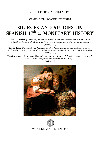 151, Cl. de Lozanne Jefferies, Sources and Studies on Spanish 17th c. Monetary History; G. de Barbón y Castañeda, Provechosos arbitrios al consumo del vellón … (Madrid, 1628); G. Basso, Discurso sobre la Proposición de labrar buenas monedas… (Madrid, 1632); F. A. de Alarcón, Advertencias para asegurar el acierto de la baja y consumo de la moneda de vellón… (Madrid, 1642), 2013, 140 pages ISBN 978-94-91384-19-6
151, Cl. de Lozanne Jefferies, Sources and Studies on Spanish 17th c. Monetary History; G. de Barbón y Castañeda, Provechosos arbitrios al consumo del vellón … (Madrid, 1628); G. Basso, Discurso sobre la Proposición de labrar buenas monedas… (Madrid, 1632); F. A. de Alarcón, Advertencias para asegurar el acierto de la baja y consumo de la moneda de vellón… (Madrid, 1642), 2013, 140 pages ISBN 978-94-91384-19-6
 152, Documents and Studies on 19th c. Monetary History, Japan, Reports of the Imperial Mint (Osaka), IV. (37th - 45th years of Meiji) (1904 – 1912), M. Kovalchuk, G. Depeyrot, 2012, 452 p. ISBN 978-94-91384-20-2
152, Documents and Studies on 19th c. Monetary History, Japan, Reports of the Imperial Mint (Osaka), IV. (37th - 45th years of Meiji) (1904 – 1912), M. Kovalchuk, G. Depeyrot, 2012, 452 p. ISBN 978-94-91384-20-2
On the "latest publications" page, are listed all the 2012 publications, specially those concerning the 19th c. monetary crisis.
For more information, or to purchase, see: www.moneta.be
THE BOOK BAZARRE
BOOK REVIEW: THE UNIFORM COINAGE OF INDIA 1835 – 1947
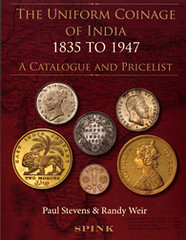 I feel obligated to start most of my book reviews with "I'm no expert in _____, but...", and this book is no exception. I'm certainly no expert in the coins of British India, so I'll defer to others in evaluating this book for numismatic accuracy. But I will hazard the following observations.
I feel obligated to start most of my book reviews with "I'm no expert in _____, but...", and this book is no exception. I'm certainly no expert in the coins of British India, so I'll defer to others in evaluating this book for numismatic accuracy. But I will hazard the following observations.
First, I was curious about the word "uniform" in the title. Why not just "The Coinage of India 1835 – 1947"? Well, the first full paragraph explained that nicely:
Centralisation of matrix die production at Calcutta, after 1835, meant that the coins became much more standardised throughout the territories of British India, so the concept of different coins being produced at different mints ... loses its significance.
The coins are indeed quite uniform, but there is plenty of diversity among rulers, denominations, mints and die varieties to make this an interesting series for the collector. These are quite beautiful coins as well, and the color images of many are striking. These were some of my favorites in my younger days as a collector of foreign coins, and I'm glad to see this book-length treatment of them. The book includes pattern coins as well, and I'm glad they're included.
The book is very nicely and cleanly laid out. Chapters are ordered by ruler from William IV (1835-1840) through George VI (1937-1947). Denomination, date and mint are the next levels of classification. Within each section are tables showing the official coin weight, actual observed weight ranges, metal composition, edge type, etc. Other tables list major obverse and reverse varieties, accompanied by excellent close-up photos of the key areas. With this book in hand one can easily be an expert in variety detection, such as the 1862 Rupee and its round and elongated pearls, and 4.75, 4.25, 3.75 and 3.33 panels to jabot varieties. While these appellations may seem like gibberish to the uninitiated, they make perfect sense from the photographs.
The catalogue tables enumerate the known date, mintmark and obverse/reverse variety combinations with values in three different conditions. The interpretation of the three price columns (labeled G1, G2 and G3) varies depending on the type of coin described. This can be confusing, but it does allow for a concise table representation. The grades generally refer to European VF, EF and UNC grades. For proof coins G1 represents later restrikes, G2 represents early restrikes, and G3 is for original strikes.
Coins are illustrated in color throughout. The book was printed in Malta and is available in hardbound, paperbound and wirebound formats. It's a very well executed book, quite fitting with Spink's high standards. I highly recommend it to collectors and students of the series.
I asked co-author Randy Weir for some background on how the book came to be. He writes:
We did this book out of a love of Indian Numismatics, lack or false information "out there" and two people able to put something together with little lapping knowledge on the whole subject.
Paul did the base, although I had him change part of it to make it more reader friendly. Here we met half way as I think it can be even more user friendly but Paul had the scholar in him and wanted to break it up the way he did. I got together most of the photos and wrote all the pricing. We were very lucky that we could use Dr. Fores collection for the photos and much of the Restrike info as most of it came from me over the past 30 years.
The most fun was looking at and getting the Patterns ready to grade The least fun was trying to figure out prices. There is no pricing guide anywhere and I had to start from scratch using my memory (scary) and research on past collections. We have made a big step for pricing and the Fore sale of Indian coins, to be sold in three parts by Baldwin's this year will help us see what people think of my pricing.
To read the earlier E-Sylum article, see: NEW BOOK: THE UNIFORM COINAGE OF INDIA 1835 – 1947 (www.coinbooks.org/esylum_v16n02a04.html)
ANS LIBRARY WISHLIST UPDATED

The ANS Library has recently updated a section of the ANS library support website. Library staff frequently get inquiries from people wishing to donate their auction catalogs. Because of space limitations here, we cannot accept all donations of every catalog, so we have prepared some listings of specific catalogs and runs of catalogs that we would very much like to acquire. Perhaps our members can help. The lists that are posted are of our MISSING catalogs (i.e. those we would like to acquire). This information will be updated as it becomes necessary.
There are so many books and periodicals that belong in the Harry W. Bass, Jr. Library but our budget is not always able to satisfy our needs. If you have an extra copy of any of the following items, or wish to purchase a copy for us, it would be much appreciated!
We would be happy to acquire ANY catalogs of the following from 2000 - present:
Dix, Noonan, Webb
Jesus Vico, Madrid, Spain
Hess-Divo
La Galerie Numismatique (Switzerland)
Munz-Zentrum (Rheinland)
WAG (Westfalische Auktions Gesellschaft)
Oslo Mynthandel
Christie's and Sotheby's (numismatic catalogs)
Asta Numismatica (Nomisma)
Books Wish List: Books are listed in no particular order.
-- Hodges, Richard. Dark Age economics: a new audit. Duckworth debates in archaeology. London: Bristol Classical Press, 2012. xiv, 160 p. ISBN 9780715636794.
-- Macé, Arnaud (ed.). Choses privées et choses publiques en Grèce ancienne: genèse et structure d'un système de classification. Horos. Grenoble: Éditions Jérôme Millon, 2012. 352 p. ISBN 9782841372690.
-- Rutishauser, Brian. Athens and the Cyclades: economic strategies 540-314 BC. Oxford; New York: Oxford University Press, 2012. xii, 304 p. ISBN 9780199646357.
-- Philippa Jane Walton. With a preface by Richard Reece. 2012. Rethinking Roman Britain: Coinage and Archaeology. Moneta, 137.
-- Stevens, Paul and Randy Weir. The Uniform Coinage of India 1835 - 1947. A Catalogue and Price List. London: Spink
-- ATTI DEL 3° CONGRESSO DI NUMISMATICA. Bari 12-13 Novembre 2010. La monetazione pugliese dall'età classica al medioevo (III). La monetazione della Messapia. La monetazione angioina nel Regno di Napoli. Ed. 2011, f.to 18x26cm., pp. 602, ill. b/n e a colori. More details online here.
-- ATTI DEL 2° CONGRESSO NAZIONALE DI NUMISMATICA. Bari 13-14 Novembre 2009. La monetazione pugliese dall'età classica al medioevo (2). Le monete della Peucezia. La monetazione sveva nel regno di Sicilia. Ed. 2010, f.to 18x26cm., pp. 414, ill. b/n e a colori. More details online here.
-- ATTI DEL 1° CONGRESSO DI NUMISMATICA. Bari 21-22 Novembre 2008. La monetazione pugliese dall'età classica al medioevo (I). La monetazione della Daunia. Le monete Normanne dell'Italia Meridionale. Ed. 2009, f.to 18x26cm., pp. 302, ill. b/n e a colori. More details online here.
-- JUVENILIA. Raccolta degli scritti presentati al Concorso per giovani numismatici "Nino Rapetti" 2011. Ed. 2011, f.to 17x24cm., pp. 192, ill. b/n. More details online here.
-- (a cura di Antonio Morello). KAMPANOS. Ed. 2010, f.to 17x24cm., pp. 176, ill. b/n. More details online here.
-- EOS. Collana di studi numismatici. IV. Circolo Numismatico Pugliese. Ed. 2012, f.to 18x26cm., pp. 374, ill. b/n e a colori. More details online here.
-- Giuseppe Amisano. ''LA STORIA DI ROMA ANTICA E LE SUE MONETE. II. L'epoca delle guerre romano-cartaginesi.'' Ed. 2011, f.to 21x29,7cm., pp. 192, numerose ill. b/n e cartine. More details online here.
-- Alberto D'Andrea - Vincenzo Contreras. LE MONETE DELLE ZECCHE MINORI DELLA CAMPANIA. Vol. III - SALERNO. Ed. 2012, f.to 15x21cm., pp. 328+15 tav a col., ill. b/n, brossura. More details online here.
-- Alberto D'Andrea - Gaetano Faranda - Elena Vichi. LE MONETE SICILIANE DAI BIZANTINI AGLI ARABI. Ed. 2012, f.to 15x21cm., pp. 842 + pp 40 a colori + 24 pagine di prezziario. More details online here.
-- Alberto D'Andrea, Christian Andreani, Simonluca Perfetto LE MONETE NAPOLETANE DA FILIPPO II A CARLO VI. Ed. 2010, f.to 15x21cm., pp. 512, ill. b/n + 48 pp. a colori + 8 pp prezziario. More details online here.
-- Gianluigi Esposito NOTE SUI "LUIGINI" DI MASSA DI LUNIGIANA Tentativo di elenco delle monete da 8 bolognini di Alberico II Cybo. Ed. 2012, f.to 17x24cm., pp. 144, ill. b/n. More details online here.
-- Giuseppe Ruotolo CORPVS NVMMORVM RVBASTINORVM. Ed. 2010, f.to 21x30cm., pp. 252, ill. b/n. More details online here.
-- Alberto Trivero Rivera GIUSTA GRATA ONORIA è il mio nome. Ed. 2012, f.to 17x24cm., pp. 144, ill. b/n. More details online here.
-- The Chips and Coupons in Old Shanghai, Tokens (2005). Editor: Pan Junxiang. Publisher: Shanghai Academy of Social Science, edited and printed in Shanghai in 2005. 279 pages. This book has nearly all local tokens, chips, coupons and tokens banknotes issued during AD 1860's to 1950's. Cited in the Esylum.
To read the complete listings, see: Wish List for the ANS Library (numismatics.org/Library/WishList)
ANS Librarian Elizabeth Hahn adds: We also have a new "store" on Amazon. The items in this list should grow over the next few weeks / months and will be continually updated as necessary.
To visit the ANS Amazon bookstore, see: www.amazon.com/shops/American_Numismatic_Society
TAMS LITERARY AWARD NOMINATIONS SOUGHT
Token and Medal Society Librarian Peter Irion writes:
If anyone knows about any new books that should be in the TAMS Library, please feel free to contact the authors directly and ask then to donate a copy of the book to the TAMS Library.
Incidentally, Whitman Publishing just sent out a copy of Fred Reed's latest book "Abraham Lincoln - Beyond the American Icon" to the TAMS Library. I would like to congratulate Fred for his hard work on this wonderful book - and I am sure he is happy to finally have this tough task behind him. I would like to thank Whitman for their generosity in donating a copy of this book.
Finally, I would like to solicit everyone's support in helping me find books and catalogs that are eligible for this year's TAMS Literary Award completion - and the Mishler Cataloging Award. To be eligible for this year's award, the book / catalog must be published in 2012, and must be a completely new work on a specific topic, and the author must be a TAMS member. 2nd editions or reprints or catalogs on very general topics are NOT eligible.
Many of you must know about books that are eligible and deserving to be entered into the competition (which will be judged by at least 3 independent judges). I need suggestions. I would even be willing to buy the books for the library - or sign up an author for membership in TAMS if they can donate a copy of their book.
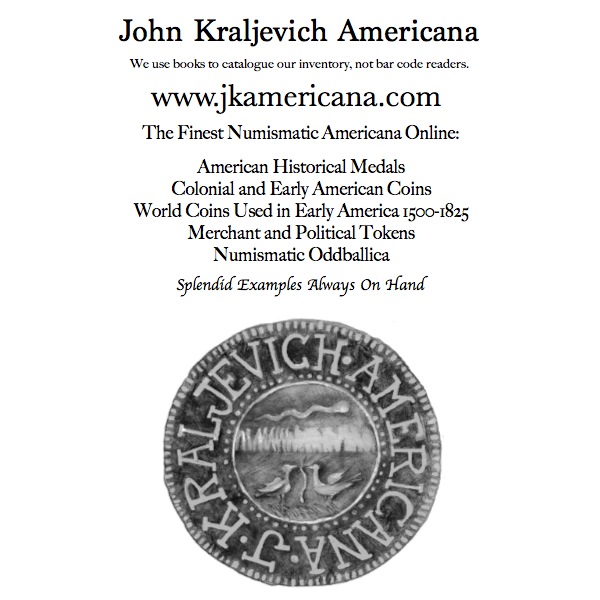
NOTES FROM E-SYLUM READERS: FEBRUARY 17, 2013
Specific Gravity Testing
Joe Boling writes:
The website giving ways to detect fake (plated) silver bars and rounds never mentioned the most reliable technique - specific gravity testing. It's not complex, and most numismatists of any longevity in the metallic side of the hobby have the equipment needed (paper money collectors probably don't).
To read the earlier E-Sylum article, see: FAKE SILVER BARS OFFERED ON EBAY (www.coinbooks.org/esylum_v16n06a15.html)
Liberty Bell Columbian Exposition Badges
Pete Smith writes:
I have an extensive collection of badges from the 1893 World's Columbian Exposition. The Liberty Bell was at the fair and there was a community celebration when it returned to Philadelphia. I am attaching a scan of two badges from this event. The longer one is about eight inches from hanger to the bottom of the tassels.
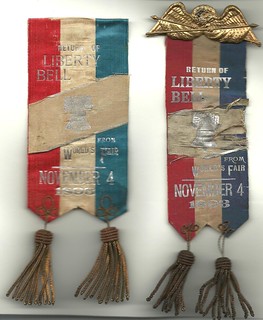
To read the earlier E-Sylum article, see: NOTES FROM E-SYLUM READERS: FEBRUARY 10, 2013: More on the Travels of the Liberty Bell (www.coinbooks.org/esylum_v16n06a08.html)
Tie Vote in Yahoo Penny Poll
Larry Dziubek writes:
The YAHOO home page is running a poll about the U.S. Mint getting rid of the "penny". Currently it is nearly a 50 / 50 tie.
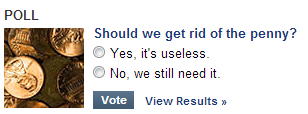
NEW YORK PUBLIC LIBRARY COLONIAL ERA ARCHIVE
Anne E. Bentley of the Massachusetts Historical Society writes:
For your readers interested in our Colonial history, the New York Public Library has digitized this collection of "approximately 10,800 historical manuscripts relating chiefly to the period prior to, during, and following the American Revolution" AND retained Emmet's archival practice of "extra-illustrating" the archive. Among the “object types” they list “Maps, Money, Muster Rolls.” Enjoy!
To access the Emmet archive, see: Thomas Addis Emmet collection (archives.nypl.org/mss/927)
Collection consists of correspondence, articles, questionnaires, and printed matter concerning the use of scrip money. Correspondence of Fisher and his associate Hans R.L. Cohrssen is with businessmen, chambers of commerce, public officials, legislators, economists, and academicians. Topics include Fisher's plan to end the economic depression of the 1930s through the use of stamped scrip, and emergency measures taken to cope with the economic crisis. Also, scripts of articles by Fisher, Cohrssen and others; questionnaires and directives on the use of scrip; and printed ephemera relating to scrip money in America and abroad.
Biographical/Historical Note
Irving Fisher (1867-1947) was an economist and professor of political economy at Yale University from 1898 to 1935.He specialized in monetary economics and in the application of mathematical techniques to the solution of economic problems.
To read the complete archive entry, see: Irving Fisher papers, 1932-1938 (www.nypl.org/archives/1264)
THE BOOK BAZARRE
ARTICLE HIGHLIGHTS 1794 DOLLAR RESEARCH EFFORTS
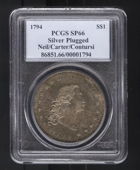 The 1794 Flowing Hair dollar that recently generated a world record price for a coin sold in a public auction is an example of how a combination of factors including individuals with decades each of numismatic knowledge and experience, continuing research, one-on-one consensus building and astute marketing helped a coin jump from $264,000 in 1984 to over $10 million 29 years later.
The 1794 Flowing Hair dollar that recently generated a world record price for a coin sold in a public auction is an example of how a combination of factors including individuals with decades each of numismatic knowledge and experience, continuing research, one-on-one consensus building and astute marketing helped a coin jump from $264,000 in 1984 to over $10 million 29 years later.
It’s also a lesson in numismatic market cycles. When legendary dealer B. Max Mehl sold the Will W. Neil collection in 1947, this coin brought $1,250, an amazing bargain by today’s value even when 66 years of inflation are factored in. But the coin actually dropped in price from $264,000 at its 1984 auction by Stack’s to $209,000 in a 1986 auction by Superior Galleries. Now it’s making international headlines for the $10,016,875 winning bid by Legend Numismatics at the Jan. 24 Stack’s Bowers Galleries auction.
For eight years I had a front row seat for many events involving the Neil/Carter/Contursi 1794 dollar and served as a consultant to the coin’s owner, Steven L. Contursi, President of Rare Coin Wholesalers. It was also during that time that building consensus among experienced numismatists and the accumulation of their expert comments added significantly more credence to the theory that this particular coin might be the very first silver dollar struck by the U.S. Mint.
There is no known contemporary documentation that this, indeed, was the first silver dollar struck. There’s no in-depth New York Times story from the scene about the Mint striking the first dollar denomination coins on Oct. 15, 1794, as the paper wasn’t founded until 1851. But theories about the significance of this particular coin have been around for decades.
For example, the description of the dollar in the January 1984 Stack’s auction of coins from the collection of Amon G. Carter Jr. stated: “The Carter 1794 silver dollar is a twin to the copper dollar (now in the Smithsonian Collection), both in surface and strike. It is perfectly conceivable that this coin was the very first 1794 silver dollar struck.”
In 2003 and 2004, arrangements were made by Contursi for more than a dozen numismatic experts to closely inspect the coin outside its PCGS encapsulation holder. The consensus of the independent experts was that:
- It is the earliest die state known (Die State I) in silver and a perfect match to the copper trial piece (Judd-19) that is believed to have been stuck first to test the dies.
- It was one of the first few made and may be the first U.S. silver dollar struck.
- It is unique as the only known surviving 1794 dollar with a silver plug to adjust the planchet’s weight.
- It is the finest known of the estimated less than 140 surviving 1794 silver dollars from the 1,758 that were minted.
- It has mirrored, proof-like surfaces indicating the planchet was specially prepared.
- It has tremendous historical importance.
The connection to the 1794 copper pattern hasn't been discussed here before, so here's another excerpt. -Editor
In 2003, Contursi brought the coin to the Smithsonian to compare it to the 1794 copper pattern in the National Numismatic Collection.
Dr. Richard Doty, Numismatic Curator of the Smithsonian’s National Museum of American History, has emphatically said there’s no proof it’s the very first silver dollar, and has even joked on more than one occasion, that “we are moving from the realm of numismatics into that of theology.”
However, in a letter to Contursi following the side-by-side examination of the coin with the 1794 dollar copper trial strike in the museum’s collection, Dr. Doty wrote:
“The die states are the same on our copper trial and the silver specimen. Neither displays evidence of a die clash, which means at least that each was coined very early in the run. The silver piece shows some evidence of having been struck on a polished planchet, as does our copper trial. Our experience is that you don’t polish planchets for production-run coins; there would be no point. All of these points suggest that the piece was intended for presentation, which suggests that it was one of the first 1794 dollars struck.”
To read the complete article, see: 1794 Flowing Hair Dollar Shows Record Price, Record Effor (numismaster.com/ta/numis/Article.jsp?ArticleId=26507)
To read the earlier E-Sylum article, see: ON THE 'FIRST' 1794 DOLLAR (www.coinbooks.org/esylum_v16n05a14.html)
For more on prior owner Martin Logies' book, see: 1794 DOLLAR BOOK PUBLISHED (www.coinbooks.com/esylum_v07n33a08.html)
THE LIFE AND COINS OF GEORGE T. MORGAN
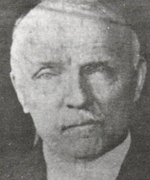 Much has been written about the coins that he designed, most famously the Morgan Silver Dollar, as well as a number of classic commemoratives and many medals struck at the Philadelphia Mint. This article will take a look into the life and work of the man, who can easily be considered to be one of the most proficient engravers ever to have worked at the US Mint.
Much has been written about the coins that he designed, most famously the Morgan Silver Dollar, as well as a number of classic commemoratives and many medals struck at the Philadelphia Mint. This article will take a look into the life and work of the man, who can easily be considered to be one of the most proficient engravers ever to have worked at the US Mint.
Going back to the time just after his arrival in the United States, Morgan enrolled in the Academy of Fine Arts after coming to Philadelphia, where his talent was soon noticed. Within a year of Morgan’s arrival in Philadelphia a large number of patterns with his designs were struck, mostly proposals for a new silver dollar. His design, with Ms Anna Williams serving as a model for the obverse and an American Eagle for the reverse, would become the Morgan Silver Dollar.
It had first been struck in half dollar size as a pattern in 1877, and while the media was not too enthusiastic about the design (which, we might add, they almost never were) the coin’s design is well respected to this day. While contemporaries of the day seemed to have preferred William’s Barber designs for the new Silver Dollar, it was Mint Director Linderman who had taken a personal liking to Morgan, and who eventually decided that it was Morgan’s design which was to be used for the new silver dollars. This design (with some minor modifications) would be struck from 1878 to 1904, and again in 1921, before it was replaced by the Peace Dollar.
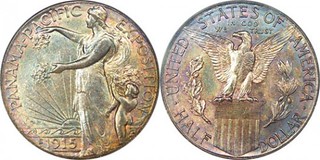
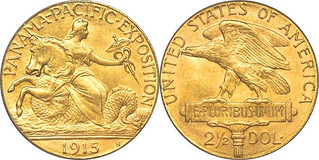
To read the complete article, see: The Life and Coins of George T. Morgan (news.coinupdate.com/life-and-coins-of-george-t-morgan-1857/)
WAYNE'S NUMISMATIC DIARY: FEBRUARY 17, 2013
Tuesday was the February meeting of my Northern Virginia numismatic social club, Nummis Nova. We gathered at the Max Fox Brewery in Falls Church. I arrived about 6:30 and we already had a nearly full table. I found an open spot across from Roger Burdette. Next to arrive were Wayne Herndon and Tom Kays, who sat across and beside me. On my right was Julian Leidman. Also present were Chris Neuzil, Joe Levine, Dave Schenkman, Eric Schena, Len Goldberg, Steve Bishop and Mike Packard.
I passed around a copy of the new Stevens-Weir book on The Uniform Coinage of India, which I reviewed elsewhere in this issue. I also passed around a copy of Whitman's new Almanac of United States Coins, which I'd just received in the mail the day before.
Since I'd missed the January meeting, I passed around some numismatic items I'd been saving to show Eric - all of my Labor Exchange notes, including two from the early London labor exchange. Our January topic was alternate currencies and fantasy notes. I also passed around my collection of NORFED "Liberty Dollar" paper notes, and a 1959 gold Celeston, from "The Nation of Celestial Space". Tom Kays took a photo of it.
Dinner conversation was all over the numismatic map, from the $10 million 1794 dollar to trashy-dressing coin dealer wives. Eric impressed me by knowing about "Sede Vacante" papal coinage. He also surprised me with a gift of a nicely inscribed copy of his new book on Ingle System tokens. There is more on both topics elsewhere in this issue. I also made sure to have Roger Burdette sign my copy of his new book on WWII Patterns. Wayne Herndon had a bundle of them in his car, and distributed some to attendees.
Chris Neuzil was our host for the evening, and he did a yeoman's job of handling the restaurant and waitstaff. Tom Kays endeared us to the waiter when he learned he had an interest in coins himself. Doing a quick market survey, he showed our waiter the Almanac and asked if he'd buy one. He looked it over and said he would. I didn't have a spare or I would have given one to him. The waiter told Tom he liked the dollar coins, and Tom paid his whole check with them.
I asked Chris if he had an new numismatic acquisitions. He had a great story to tell, and he wrote it up for The E-Sylum.
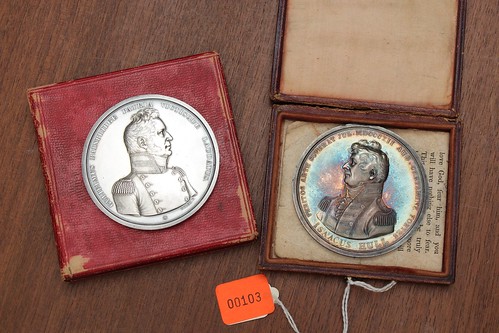
Chris Neuzil writes:
In 1999, two original War of 1812 silver medals came to the market (through Joe Levine) from a non-numismatic auction. They were for two of Constitution's victories - under Captains Isaac Hull and William Bainbridge and would have been given to officers involved in those battles. Most surviving examples are now anonymous. There seemed a possibility that the two were to a single officer who served in both battles, and there was only a 1950-dated estate document with them but the names I didn't recognize; the auction house wouldn't or couldn't put me in touch with the consignor.
Since I already owned a Bainbridge from the Middendorf collection, I bought the Hull medal. My friend Lenny Vaccaro bought the Bainbridge and years later sold it through Stack's at their 2009 Americana sale.
Last May provenance expert Kay Freeman kindly offered to try to link the names on the estate document with an officer on Constitution. By then I had rosters of officers and sent the list of possibles. Within about an hour (!) she emailed back that my Hull medal traced to Amos A. Evans, physician, student of Benjamin Rush, prolific diarist, and surgeon on Constitution.
Needless to say, I regretted passing up Evans' Bainbridge medal and started putting out feelers. Incredibly, it was offered later that year again by Stack's, but with a very high reserve and did not sell. More feelers, and things came together. Evans' two medals (photo) are back together. The Bainbridge is still in its original red morocco case, to my knowledge the only one surviving from the War of 1812 awards.
Evans' diary is one of the few written accounts of Constitution's early cruises. After Navy service, Evans practiced medicine in his hometown of Elkton, Maryland. His grave is in the Elkton Presbyterian Church cemetery.
As usual, it was a wonderful evening of numismatic fellowship. I'm already looking forward to next month.
MORE ON THE ERIC NEWMAN COLLECTION SALES
We've made a small beginning regarding the Eric P. Newman collection held by EPNNES (Eric P. Newman Numismatic Education Society). I can announce that the collection of United States Patterns will be sold by Heritage at the Central States Numismatic Society show in Schaumberg, IL The tentative date of sale is the evening of April 25th. Also included will be an original 1845 Silver and Copper Proof set and an extraordinary 1852 Augustus Humbert $10 gold piece.
In response to your future sales queries, there are currently no definitive plans to sell the Large Cents, any part of the numismatic library, or any additional collections. Other than the general goal announced by the EPNNES foundation on January 9th, no decisions as to extent or timing of sales have been made. The numismatic community will be kept abreast of any future sales in an exceedingly timely manner.
In response to your query regarding myself and my association with Eric: I have been a student of Numismatics since 1975 and a full time dealer since 1979. My friendship with Eric began many years ago with correspondence regarding 1779 South Carolina Bills of Credit engraved by Thomas Corum of Charleston. Our mutual interest in Colonial Currency led to further reciprocal research, including Paul Revere's production of the iconic "Sword in Hand" legal tender Bills issued by Massachusetts in 1775 and 1776. My wife Maureen and I also assisted Eric with the 5th edition of "The Early Paper Money of America" published in 2008.
In my opinion, Eric P. Newman is the foremost numismatic researcher of our time. The EPNNES collections represent his gateway to numismatic knowledge. I am honored to have been chosen to advise EPNNES and will do my best to further the study of Numismatics in conjunction with this task.
To read the earlier E-Sylum article, see: ERIC P. NEWMAN NUMISMATIC EDUCATION SOCIETY PLANS SOME SALES (www.coinbooks.org/esylum_v16n02a09.html)
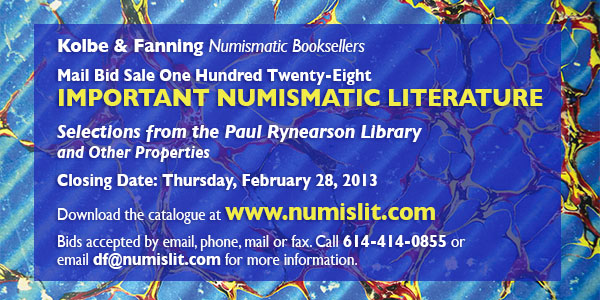
QUERY: WHERE IS THE RUTH HILL WORLD PAPER MONEY COLLECTION?
I would like to know the present location of the world paper money collection of Ruth Hill (Mrs. Adolph B. Hill 1898-1995). She began collecting paper money in the 1950's, shortly after her husband died. She was one of the founding members of the International Bank Note Society (IBNS), and her collection is said to have been huge.
When the Keller manuscript for a catalog of world paper money became available in the 1960's, she bought it and donated it to the IBNS. The plan was for the IBNS to publish it, country by country, and several sections were published. I heard after her death that she had willed her collection (rich in signature varieties and other varieties) to one of the numismatic societies -- perhaps the ANS in New York. Can anyone confirm this?
I also spoke some years ago with St .Louis coin dealer Dusty Royer, who was appointed to "prepare" the collection for the organization. He told me he took out a lot of duplicates and disposed of them before turning it over. I hope this doesn't mean he stripped out all those varieties which Mrs. Hill spent a lifetime obtaining. But I do know that Ruth often bought banknotes in lots, and she may very well have had duplicates even of the varieties. How can we find out? Where is the collection today?
I should have checked my files before asking for information about Ruth Hill's collection. In the file I have a clipping from Coin World 25 May 1998 (page 40), containing an article by Gene Hessler on Ruth Hll (including a photo of her at a coin show). The article begins:
"In the Oct. 6, 1997 issue of Coin World, Michele Orzano informed readers about the collection of the late Ruth Hill, that will be made available to collectors in late 1998. ..... She made certain her collection would remain intact as a research collection for serious collectors."
This suggests the collection was donated to some organization, but doesn't say which one. I don't have a clipping of Orzano's article, so I don't know what was reported in that article. I also remember hearing a rumor that the collection was donated to Eric Newman's Numismatic Museum in St. Louis. If true, this would explain why the collection has disappeared. The museum is still open, now at the campus of Washington University in St. Louis. Newman's numismatic library is also on display at the museum, but cannot be used (except by special appointment). The museum is very small, but the display contains many fabulous Missouri notes. Is Ruth Hill's world collection also there?
WEB RESOURCES FOR NUMISMATIC WRITERS
Pete Smith writes:
My list of top ten websites would depend on my current project. Some weeks I might visit 100 different sites without repeating.
I am known for biographical research. I have bookmarks for the LDS Church FamilySearch Site and the Social Security Death Index. I don't subscribe but I use commercial sites like RootsWeb and Ancestry.Com. Through my local library, the Hennepin County Library, I can access census records. In an area related to biography, I also have a bookmark for the Library of Congress site.
This is not a site but I am a big user of Google Books looking for items that are not in my library. Sometimes I am amazed by what I can find and other times I am annoyed that something is not yet available.
For my current research into the coinages of 1792, I frequently go back to the Heritage Auctions site to look up past sales listings.
Another site that should be as valuable is the Stack's Bowers site and their file of past auctions on the site Legacy.Stacks. This is, however, a big disappointment. They no longer have images from sales by the former firms of Stack's, Bowers and Merena and American Numismatic Rarities.
In general, I am trying to find new information from some obscure source rather than looking for research others have done and posted on numismatic sites.
https://familysearch.org/
http://www.rootsweb.ancestry.com/
http://www.ancestry.com/
http://catalog.loc.gov/
http://www.hclib.org/
http://www.ha.com/
http://legacy.stacks.com/
Pete adds:
The Social Security Death Index is also available through ancestry.com. Some of the databases available through the Hennepin County Library require a library card number.
Ed Hohertz writes:
My research is in medieval Islamic coins of North Africa and Spain. Finding articles and books in the U.S can be difficult, but the following are great resources. I omit sites that are coins only (some great sites also).
1. World Catalog: (available at home through connection from the local library) catalogs all the books from cooperating libraries around the world and lists the libraries where they may be found. Also gives web sources where appropriate. http://www.worldcat.org/
2. Google, Google Books and Google Scholar. Sounds like they would give the same results, but they do not. www.google.com , books.google.com , scholar.google.com .
3. JSTOR: (available at home through connection from the local library) Another means of searching for articles on-line. www.jstor.org
4. ANS Library: Excellent source on finding published material. donum.numismatics.org/cgi-bin/koha/opac-search.pl
5. Academia.edu: a good source for newer academic articles, if the author participates. academia.edu
6. Digital library Nummis: Huge selection of on-line articles and books (mostly older because of copyright issues) for coins of every era and continent (except Antarctica!). members.ziggo.nl/tverspag/NUMIS/
7. Dialnet: Great resource for academic material published in Spain. dialnet.unirioja.es/servlet/buscador
8. Converting AH and AD Dates: www.muslimphilosophy.com/ip/hijri.htm
9, 10: Koran/Quran search sites:
www.quranbrowser.com
and
www.searchtruth.com/search.php?keyword=%D8%B3%D8%A8%D8%AD%D9%
86+&chapter=&translator=1&search=1&start=0&records_display=10&search_word=all
To read the earlier E-Sylum article, see: SURVEY: WEB RESOURCES MOST USED BY NUMISMATIC WRITERS (www.coinbooks.org/esylum_v16n06a12.html)
B. MAX MEHL'S 'A ROYAL SALE'
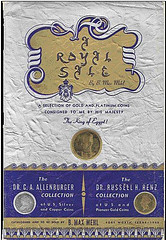 B. Max Mehl, a solo practitioner, held a whopping 116 auctions between 1906 and 1955. John W. Adams, in his indispensable two-volume United States Numismatic Literature, has examined — and graded for quality — every auction catalog issued by every major American coin dealer. One quarter of Mehl’s auctions earned an A-minus or better from Adams, mainly due to the quality of the coins cataloged within.
B. Max Mehl, a solo practitioner, held a whopping 116 auctions between 1906 and 1955. John W. Adams, in his indispensable two-volume United States Numismatic Literature, has examined — and graded for quality — every auction catalog issued by every major American coin dealer. One quarter of Mehl’s auctions earned an A-minus or better from Adams, mainly due to the quality of the coins cataloged within.
Mehl’s consignors comprised an all-star numismatic lineup: H.O. Granberg, James Ten Eyck, William Forrester Dunham, William Cutler Atwater, Will Neil and even King Farouk of Egypt.
No one could showcase a numismatic collection like Max, as the cover of “A Royal Sale,” featuring coins from King Farouk’s collection, amply demonstrates.
The cover also exemplifies Mehl’s resourcefulness, for the king had refused permission to use his portrait as the cover illustration, so Mehl used an Egyptian coin featuring Farouk on the obverse!
Mehl did not auction every collection he handled; some he bought intact and sold at fixed prices. Prime among them were the large cents of Dr. George French and the encyclopedic collection of Waldo Newcomer, for which Mehl paid a king’s ransom — $220,000 — in 1933, the worst year of the Great Depression.
Max could spend lavishly because he had deep-pocketed customers like Col. E.H.R. Green, son of the “Witch of Wall Street,” financier Hetty Green. Mehl sent catalogs to all four of Green’s homes for six years without a response, before finally cracking the colonel’s sales resistance. Green’s first order was for $1,800, which proved but a rehearsal for his second, which totaled $63,500! Remarkably, Mehl did not conduct a single public auction; all 116 were mail-bid sales.
To read the complete article, see: B. Max Mehl's 'A Royal Sale' (www.coinworld.com/Articles/ViewArticle/b-max-mehls-a-royal-sale)
WAYTE RAYMOND'S "COIN TREE" HOLDER IMAGES SOUGHT
Dave Lange (who is working on a book about the Wayte Raymond "National Coin Album holders) writes:
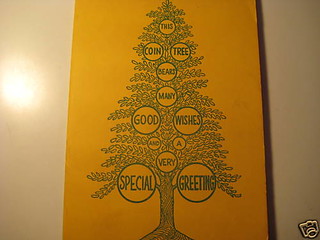 I need to appeal to the readers. The only thing remaining to complete my book is the color photography. I'm lacking one important item in my own collection, and I have only low resolution Internet images.
I need to appeal to the readers. The only thing remaining to complete my book is the color photography. I'm lacking one important item in my own collection, and I have only low resolution Internet images.
The item in question is Wayte Raymond's "Coin Tree." This was a promotional holder in portrait format that was distributed with the coins already in place. The front cover has a drawing of a tree and reads in eight lines "THIS COIN TREE BEARS MANY GOOD WISHES AND A VERY SPECIAL GREETING" The example for which I have small photos is gold colored, but it may have come in other colors, as well.
I would like to either borrow this item from someone who has it and have my own photos taken or receive good quality photos suitable for publication. Needless to say, I would also be a buyer for such an item if it might be for sale.
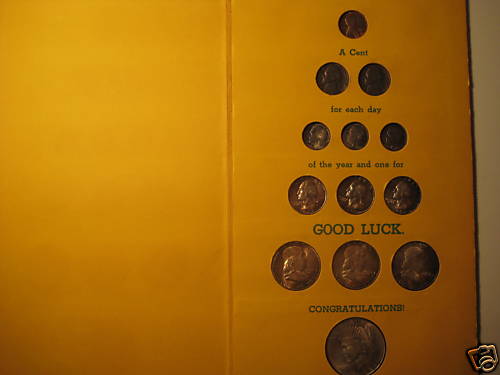
To read the earlier E-Sylum article, see: RAYMOND-BEISTLE CHRISTMAS TREE COIN HOLDER (www.coinbooks.org/esylum_v14n53a21.html)
THE BOOK BAZARRE
WORLD COIN EXPERT POSITION OPEN AT HARLAN J. BERK LTD.
Harlan J. Berk Ltd. is searching for qualified and energetic World coin expert to run our department. We had a wonderful employee, Roxana Uskali, who started with us at the age of 21 and over 9 years grew the department by leaps and bounds. Ms. Uskali, who also has a small outside business, left us recently for greener pastures. We wish her well in her future endeavors!
The job requires a strong knowledge of world coinage and experience is necessary. The job is great for someone that has a love of history and wants to put that knowledge to some good use. Collections are routinely brought in that need to be analyzed and written up and there is room for growth. Participation in auctions, both domestically and internationally, would be possible and urged.
Harlan J. Berk Ltd., is one of the largest numismatic firms in country. If interested in the position, salary and specifics to the job can be further discussed by calling Shanna or Harlan at 312-609-0026 or email at shanna@hjbltd.com .
We’d love to meet you if you have a love for history and interest in coins!
U.S. COIN BUYING GUIDE HISTORY
Regarding last week's question about prices in a 1959/60 coin buying guide, Bill Eckberg writes:
The prices for half cents and early large cents are at or below the 1947 Red Book values for coins in Good. If they are offering to buy any coin with a readable date at that price, prices in a guide book may or may not have much relevance.
Ken Bressett writes:
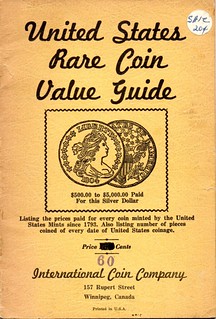 I can shed some light on the “Canadian Coin Buying Guide” mentioned in last week’s E-Sylum. It was not a Canadian product, but was in fact produced in Chicago by Lee Hewitt and his brother Clifford. Lee was publisher of the Numismatic Scrapbook Magazine that was the only commonly available numismatic literature for collectors from around 1937 to 1960.
I can shed some light on the “Canadian Coin Buying Guide” mentioned in last week’s E-Sylum. It was not a Canadian product, but was in fact produced in Chicago by Lee Hewitt and his brother Clifford. Lee was publisher of the Numismatic Scrapbook Magazine that was the only commonly available numismatic literature for collectors from around 1937 to 1960.
Lee ran a print shop in Chicago and was a serious collector of United States coins. With the growing popularity of his monthly magazine he hit upon the idea of producing a companion product that would give collectors some idea of what coins were worth. That was a time when dealers were known to pay whatever prices they chose for coins, with no guidance or regard for fairness. The “Buying Guide” he devised gave some hint of what prevailing prices were throughout the country. Prices were incredibly low at that time when the country was just beginning to recover from the great depression. Even so there were dealers who paid only rock bottom prices to unsuspecting owners of old coins.
The Hewitt book never bore his name as the source. It was a generic publication with a blank space on the front cover where any dealer could have his name and business address imprinted. I suspect that the ‘blank’ books were sold in bulk for around 10c each. They had a cover price of 50c to add to their respectability, although I think that dealers that used them simply gave them to potential customers.
I found only a few of these old catalogs on my library shelf. The oldest was c. 1949 and has a blue cover, and yes, the price shown there for a Pine Tree 6d was $5.00. Yet, that was not unreasonably low when the retail value was only around $15. Another similar edition with brown cover was from c. 1952. Prices in this edition are somewhat higher for many coins, but not for the Pine Tree pieces. A third version from around 1962 has a different style cover showing a Lincoln Cent. This has much higher prices for just about everything, and the Massachusetts silver pieces are now priced at $12.
Lee Hewitt and coin dealer Charles Green, were both prominent Chicago numismatists. It was with the help of these two men that R. S. Yeoman put together his now famous Handbook of U.S. Coins (the Blue Book). The names of these three men are on the cover of early editions as co-authors. Many if the illustrations in both the Hewitt booklets, and the Blue Book are the same, as are the general listings and organization.
I have never been sure of which came first, but there was an obvious cooperation between these publications. Yeoman told me on several occasions that he began publishing the Blue Book with the intention showing realistic prices for U.S. coins without bias or any self-serving interest. His philosophy has served the publication and the hobby well for the past 70 years.
To read the earlier E-Sylum article, see: QUERY: 1959 COIN BUYING PRICES (www.coinbooks.org/esylum_v16n06a14.html)
JOHN HUFFMAN AND GORDON FROST
Howard Daniel wrote that John Huffman retired from the IRS 12/31/2010, after nearly 40 years of service. He was a good friend of Gordon Frost, and John helped arrange for the sale of Gordon's numismatic library.
Dave Hirt writes:
I was really shocked to read that John Huffman had died. I first met him years ago at Frank Katen's public sales. He usually had two or three bidder numbers, so he was representing other buyers besides himself. He was always together with Gordon Frost. I believe Gordon stayed with John whenever he came to the Baltimore-Washington area.
After Gordon died, John told me he was helping Gordon's widow prepare the library for sale. He said that it was slow going because he was looking for certain rare books that he knew Gordon owned, but because of "books laying around everywhere" it was not an easy task.
John also had an interest in Spanish-American coins. This was probably was in connection with the sunken treasure interest that was mentioned. It is sad that these two good friends are gone from us within a short time.
Simcha Kuritzky adds:
John Huffman was also an avid collector of vampire books and medals. He had some coins related to Vlad the Impaler, as well as Vampire Francaise satirical medals. One of his last projects was putting together a collection of coins along the Silk Road contemporary with Marco Polo.
To read the earlier E-Sylum article, see: JOHN HUFFMAN (www.coinbooks.org/esylum_v16n06a06.html)
THE BOOK BAZARRE
GROVER CRISWELL'S CONGRESSIONAL TESTIMONY ON GOLD OWNERSHIP
I knew Grover Criswell and his wife, Dolly, on a casual; basis until 1978, when, just a year or two out of law school, Grover appointed me to the position of Legislative Counsel to the American Numismatic Association (I stayed in that position for many years, finally leaving at the end of my own presidency in 1995.
There are some who thought Grover to be a lightweight, but of all the presidents that I worked with, he understood the political process best and what the purpose of a legislative counsel was – namely to work with Congress, and to help the president testify (and to offer background information to members of Congress and theirs staff to aid in that process).
Back in 1978, Congress began the debate over whether the U.S. should compete with the Krugerrand. Treasury fought it mightily Hearings were held in the Senate Banking Committee, and some real heavyweights came out to make out the case of why the U.S. government shouldn’t be in the bullion business.
The ANA’s annual convention was going on in Houston (Grover had Judge Hofheinz's suite at the Astrodome) and he decided that we should go to Washington to testify. I wrote his prepared remarks and, as was my custom, a three minute summary that he could read into the record. I also took index cards so that I could jot ideas and concepts for Grover to respond to questions from Senators or even fellow witnesses. Should anyone ask, Grover was a big man and wound up in a coach seat. I was staff, but managed to get 1st class. (I immediately switched with him).
C. Fred Bergsten, a respected international economist and then assistant secretary of the Treasury, testified before the Senate Banking Committee instead of Secretary W. Michael Blumenthal. He declared, “The [Carter] Administration believes that issuance of gold medallions would be unwise and inappropriate for several reasons, which he enumerated.
First, he said, “the issuance of these medallions would tend to create the erroneous impression that the U.S. government needs to supply the public with an officially issued gold piece as a hedge against inflation.”
Second, “the production and sale of an American medallion... could be interpreted as a U.S. government effort to encourage investment in gold. “
Third, issue of gold medallions “would be inconsistent with U.S. policy of continuing progress toward demonetizing gold.”
He postulated that, horror of horrors, a legal tender version of the medallions might follow – or that the medallions themselves would be monetized.
Dr. Edward M. Bernstein, a respected economist who formerly was a high Treasury Department official, active with the International Monetary Fund, and the Bretton Woods agreements, also spoke out on economic and policy grounds.
An apologist for the official, long-held view that gold ownership should not be allowed privately, and that the metal should be demonetized, Bernstein’s positional history carried a lot of Congressional weight. He was professor of economics at the University of North Carolina, 1935-1940; principal economist for the United States Treasury Department, 1940-1946; assistant to the secretary of the United States Treasury Department, 1946; research director of the International Monetary Fund, 1944-1958; President of EMB (Ltd.) Research Economists, 1958-1981; and guest scholar at the Brookings Institution beginning in 1982.
His advice, on the day that gold topped $198 an ounce in London: “it’s a terrible mistake to offer Americans this extra inducement to buy gold coins.” His rationale: ”it is really not right for the Government of the United States to offer an inducement to people to buy gold coins by giving them a nice looking medallion for which they would have to pay 12 percent above the bullion value.” Put differently, “it’s not a good hedge”.
Standing up for the right to own gold, and for the medallions was then-President of the American Numismatic Association Grover C . Criswell, Jr. I accompanied him, and wrote his written testimony, as ANA legislative counsel.
Criswell’s summary of five reasons why gold medallions were appropriate (it being obvious that Congress was at least several years away from authorizing gold coins): (1) it helps the balance of payments (2) clear domestic economic beneficial effects from the sale, (3) Denies $600 million in assistance to South Africa (4) returns gold to the people who have it to the government in the first place – the American people and (5) raises more money than the government’s auction plans for gold bricks in $80,000 units and above,
Bernstein then went on in the questions and answer portion to recite the proposition that “gold is gold. A person who buys a Krugerrand has just the same gold... My objection to the medallion is not that we are selling the gold but that we are putting the symbol of the United States on it which will make it more attractive.”
As future events would show, gold is not gold – and U.S. legal tender gold coinage consistently sells for more than the South African counterpart.
From August, 1978 until January, 2013, gold has gone up, down. But those who would have bought bullion then (or gold medallions when they were finally authorized in November, 1978 by Public Law 95-620), and issued in 1980 and afterwards, didn’t do that badly.
Grover Criswell’s fight for gold medallions (which ultimately became American Arts Gold Medallions)was on the right track and the result eventually led to private gold ownership. Grover took any of my index Card suggestions and broke into discussion and just pitched the ideas.
Grover and I travelled back to Houston uncertain of what Congress would do, but I was proud that he could take an index card with just a couple of words on it and speak for two or three minutes about it. That night back in Houston at the Astrodome, Grover held a party that they still talk about. But that’s a story for another day...
To read the earlier E-Sylum article, see: MORE ON GROVER CRISWELL (www.coinbooks.org/esylum_v16n06a11.html)
MILITARY PAYMENT CERTIFICATE DESIGNER LEONARD BUCKLEY
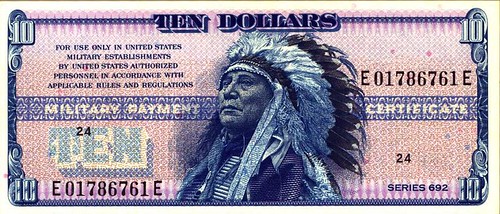
Leonard Buckley, designer of military payment certificates (MPC) and fine artist will make the key note presentation at MPCFest on March 16 in Port Clinton, Ohio.
He is best known among MPC collectors as the designer of MPC Series 692 which is also widely recognized as the most beautiful series of MPC. Because of the extraordinary designs Series 692 is also of interest to many collectors who are not MPC specialists.
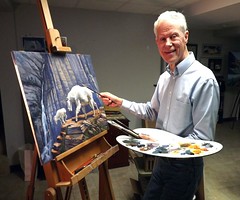 Len’s artistic career as a designer was focused on literally making money. Out of high school, he began a seven year apprenticeship in New York, training in the art of steel die and intaglio plate making used to print world-wide currencies, postage stamps and financial securities.
Len’s artistic career as a designer was focused on literally making money. Out of high school, he began a seven year apprenticeship in New York, training in the art of steel die and intaglio plate making used to print world-wide currencies, postage stamps and financial securities.
With a total of ten years experience, he moved on in 1967 to Washington DC at the U.S. Treasury’s Bureau of Engraving and Printing to begin his artistic career as a bank note designer. After six years, he went on to become the supervisor of the bank note design staff. In his 32 years with the Bureau of Engraving and Printing, he was responsible for the designs of many postage stamps, currency, Military Payment Certificates and security documents for the federal government.
In his personal studio, he kept his artistic hand active, designing and illustrating for stamp and medallion collectibles. His renderings and paintings hang in private collections, some having been donated to the Smithsonian Institution’s collection in Washington, D.C.
Since retirement from federal service, Len designed and rendered the Colorado State Quarter as part of the Artistic Infusion Program with the United States Mint. He stays active in the Baltimore Watercolor Society, the Washington Calligrapher’s Guild, the Hanover Area Arts Guild and the Adams Count Arts Council, wonderful outlets for his watercolor and oil paintings and pencil renderings.
Buckley's presentation at MPCFest will be at 1:30 PM (Festers would like to call it 1330 hours) on March 16.
MPCFest is held at the Holiday Inn Express, 50 NE Catawba Rd Port Clinton, OH 43452, (419) 732-7322. The Fest is from Friday evening March 15 through Sunday afternoon March 17. Participation at the Fest is by preregistration, but this year there are opportunities for participation without full Fest registration.
A free bourse will be held from 1100 to 1600 on Friday March 15. Interested collectors can attend the Buckley presentation on Saturday. Ten seats have been reserved at $20 each. For reservations or information contact the Fest at fredschwan@yahoo.com
PERIODICAL: MÜNZEN & SAMMELN
Bob Knepper writes:
In 2009, and possibly currently, there is/was a German numismatic publication abbreviated "M&S". Can you, please, or someone, tell me the complete title.? I want to reference an excerpt which I have - but the title is only abbreviated on my pages. It is probably/possibly "Münzen & Sammler" but ? My web search didn't reveal it.
Thank you - and for
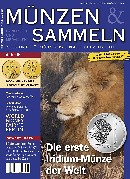 I knew just who to contact about this - Ursula Kampmann, editor of CoinsWeekly, who responds:
I knew just who to contact about this - Ursula Kampmann, editor of CoinsWeekly, who responds:
It is a journal named Münzen & Sammeln, for which I write occasionally.
For more information on Münzen & Sammeln, see: www.gietl-verlag.de/zeitschriften/muenzen-sammeln/zeitdetail/2.html
THE DISTINGUISHED WARFARE MEDAL
 The Pentagon is creating a new high-level military medal that will recognize drone pilots and, in a controversial twist, giving it added clout by placing it above some traditional combat valor medals in the military's "order of precedence."
The Pentagon is creating a new high-level military medal that will recognize drone pilots and, in a controversial twist, giving it added clout by placing it above some traditional combat valor medals in the military's "order of precedence."
The Distinguished Warfare Medal will be awarded to pilots of unmanned aircraft, offensive cyber war experts or others who are directly involved in combat operations but who are not physically in theater and facing the physical risks that warfare historically entails.
The new medal will rank just below the Distinguished Flying Cross. It will have precedence over -- and be worn on the uniform above -- the Bronze Star with Valor device, a medal awarded to troops for specific heroic acts performed under fire in combat.
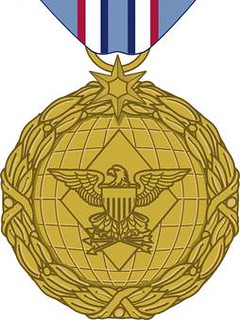 The new medal is a brass pendant, nearly 2-inches tall, with a laurel wreath that circles a globe. An eagle is in the center. The ribbon has blue, red and white stripes.
The new medal is a brass pendant, nearly 2-inches tall, with a laurel wreath that circles a globe. An eagle is in the center. The ribbon has blue, red and white stripes.
"This award recognizes the reality of the kind of technological warfare we are engaged in the 21st century," Defense Secretary Leon Panetta told reporters in Washington on Wednesday.
The new medal will be awarded for specific acts, such as the successful targeting of a particular individual at a critical time.
"Our military reserves its highest decorations obviously for those who display gallantry and valor in actions when their lives are on the line, and we will continue to do so," Panetta said.
"But we should also have the ability to honor the extraordinary actions that make a true difference in combat operations," Panetta said. "The contribution they make does contribute to the success of combat operations, particularly when they remove the enemy from the field of battle, even if those actions are physically removed from the fight."
To read the complete article, see: New medal for drone pilots outranks Bronze Star (www.usatoday.com/story/news/nation/2013/02/13/new-medal-for-drone-pilots/1917735/)
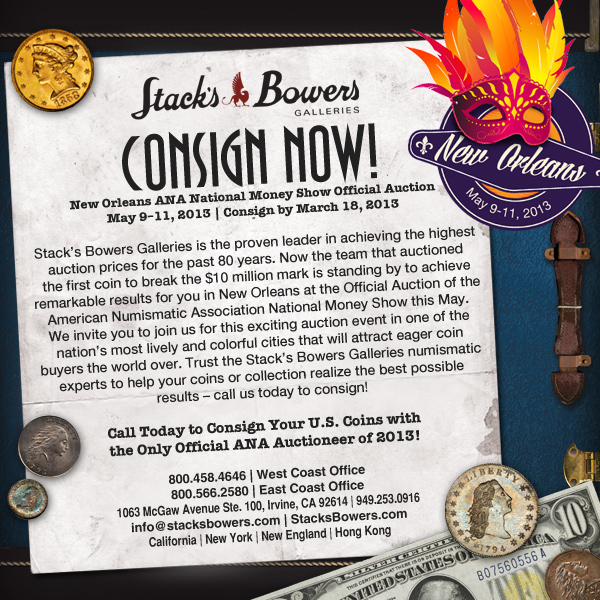
VATICAN SEDE VACANTE: POPE BENEDICT XVI RESIGNS
Transitional papal coinage is typically issued in any interregnum between the reigns of two popes. The interim period is called "Sede Vacante", or "vacant seat". With the "heads' up" from Benedict, the Vatican has a short head start on the process of selecting a new Pope. Will there be a Sede Vacante period this time, and if so, how long might it last? Long enough to issue Sede Vacante coins and medals? -Editor
P.K. Saha writes:
The news website euronews is reporting that the Pope will resign on the 28th February 2013 because he no longer has the strength to fulfill the duties of his office. This will be the first time since the early 15th century that a Pope has retired. Conclave to elect the new pope will be held in March.
Once a new pope is elected, the Vatican will issue a new standard coin set (4th Series) featuring the new pope. Pope Benedict was elected in April 2005 but the new standard set was issued 1 year after - April 2006, thus, it is very likely that the new 4th series will be issued next year. However, since this time the Vatican will not issue a Sede Vacante standard coin set, it might issue the new standard coins this year.
During last Sede Vacante, the Vatican has issued a new series of standard coins, however, this won't happen this time as the EU has changed the rules - now the Vatican is allowed to issue another 2 euro commemorative coin to commemorate the Sede Vacante - thus this year we can expect two €2 commemorative coins from the Vatican.
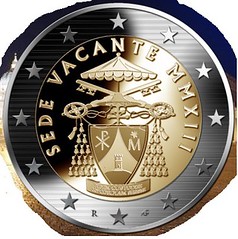 He also forwarded this artist's concept of a new Vatican Sede Vacante coin design. Thanks!
The artist displays designs for a number of fantasy Euro coins and notes:
COINS & NOTE DESIGNS
(www.webalice.it/annovi.frizio/p_eurofantasy29.html)
He also forwarded this artist's concept of a new Vatican Sede Vacante coin design. Thanks!
The artist displays designs for a number of fantasy Euro coins and notes:
COINS & NOTE DESIGNS
(www.webalice.it/annovi.frizio/p_eurofantasy29.html)
To read the earlier E-Sylum articles, see:
MORE ON TRANSITIONAL PAPAL COINAGE
(www.coinbooks.org/esylum_v08n15a03.html)
VATICAN COINS COULD BECOME AVAILABLE IN CIRCULATION
(www.coinbooks.org/esylum_v12n49a18.html)
MELTED CANADIAN POLYMER NOTES
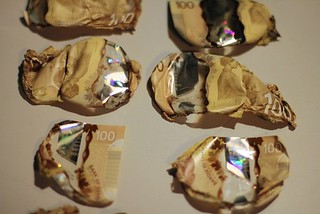
When Nicholos Billard's employer at an Ontario construction company gave him eight newly printed Canadian $100 bills as a Christmas bonus in 2011, he tossed them in an empty coffee can.
The next morning, they were shriveled—by the heat of a nearby radiator, says his mother, who made local headlines when she tried to get the bills replaced.
Canada started rolling out new, polymer-based $100 bills two years ago, followed by 50s and then, last November, 20s. The money—slick like a sheet of plastic, hard to fold and partly transparent—is more difficult to counterfeit than Canada's old paper-and-cotton bills. Australia and New Zealand have used similar, plasticized notes for years. The U.S. has no plans to introduce them.
They've been a hard sell here so far, forcing the central bank to defend them against a growing list of allegations: They don't work in vending machines; they clump together; they melt.
A more common complaint for all three denominations of the new notes: The plastic bills tend to stick together. Canadian Jeremy Taggart, drummer for alternative-rock band Our Lady Peace, complained in a recent tweet about the currency after accidentally handing a cashier three clingy, new $20 bills when he meant to hand over just one.
"They are sticky, and thin, and annoying," Mr. Taggart says. The bank has said all new bills tend to stick together at first because of how tightly they are packaged, and that the problem will fade.
To read the complete article, see: Canada's New Banknotes Strike Some as Loonie (online.wsj.com/article/SB10001424127887323511804578297993757700724.html)
The Bank of Canada considered celebrating gay marriages, black hockey players, and turban-wearing RCMP officers on its new plastic bank notes — but eventually nixed them all in favour of the more traditional images of a train, a ship and a monument.
Internal documents show that focus groups and a Bank of Canada team reviewed a series of currency images intended in part to reflect the diversity of Canada's population, particularly the country's varied ethnic character.
Images that were considered included a Chinese dragon parade, the swearing in of a new citizen, Toronto's annual Caribbean festival, children of different ethnic backgrounds playing hockey or building a snowman, and a person in a wheelchair playing basketball.
To read the complete article, see:
Gay marriage, turban-wearing Mounties nixed as Canadian bank notes: report
(www.theprovince.com/business/Canada+nixes+gays+blacks+Sikh+
Mounties+from+plastic+bank+notes/7946218/story.html)
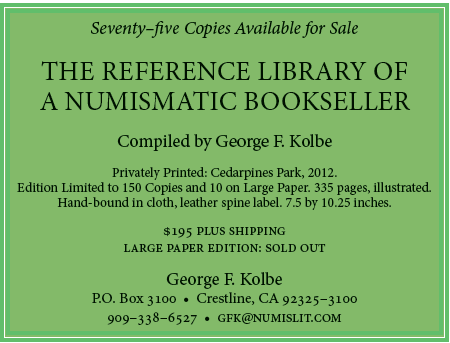
PURPLE HEART, OTHER MEDALS REUNITED WITH FAMILY
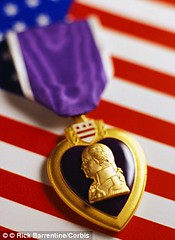 A daughter, who never knew the story of her heroic father's life, will receive eight medals for bravery awarded to him today after they were discovered by accident in the laundry room of an apartment block.
A daughter, who never knew the story of her heroic father's life, will receive eight medals for bravery awarded to him today after they were discovered by accident in the laundry room of an apartment block.
Hyla Merin, of Westlake Village, California, will receive a series of honors awarded to her father 2nd Lt Hyman Markel for his bravery in World War II.
The medals, including a Purple Heart and a distinguished Silver Star - awarded for gallantry, have begun her long road to discovering the story of her father, a heroic Rabbi's son who died protecting others against German troops just five months before she was born.
Merin's mother, Celia Markel, was given most of the medals but for some reason never received the Silver Star.
The young widow was clearly traumatized by losing her first love and rarely spoke to her daughter about him.
In the 1960s she moved into a West Hollywood apartment where she stored a box of precious mementos of her late husband - including the medals - in a laundry room looker.
They remained there forgotten about until September last year when the manager of the building stumbled upon them and contacted the veteran's charity.
To read the complete article, see:
Daughter to be given Purple Heart her father was awarded after he was killed in heroic charge on Nazis before she was even born after his medals are found in laundry room
(www.dailymail.co.uk/news/article-2280030/A-California-woman-heroic
-father-killed-WWII-finally-receive-medals-awarded-bravery-discovered-laundry-room.html)
VIDEO: COIN ROLLING ON TREADMILL
To view the video, see: Coin rolling on treadmill (www.youtube.com/watch?v=n7GN_FXgmaE)
FEATURED WEB PAGE: NATION OF CELESTIAL SPACE
This week's Featured Web Page is the Wikipedia entry on the Nation of Celestial Space.The Nation of Celestial Space (also known as Celestia) was a micronation created by Evergreen Park, Illinois, resident James Thomas Mangan. Celestia comprised the entirety of "outer space", which Mangan laid claim to on behalf of humanity to ensure that no one country might establish a political hegemony there. As "Founder and First Representative", he registered this acquisition with the Recorder of Deeds and Titles of Cook County on January 1, 1949. At its foundation Celestia claimed to have 19 members, among them Mangan's daughter Ruth; a decade later a booklet published by the group claimed that membership had grown to 19,057.
Mangan was active for many years in pursuing his claims on behalf of Celestia; in 1949 he notified the United States, Soviet Union, United Kingdom and United Nations that Celestia had banned all further atmospheric nuclear tests. Later, as the space race got underway in earnest he sent angry letters of protest to the leaders of the Soviet Union and United States on the occasions that their early space flights encroached upon his "territory" - although he later waived these proscriptions to allow for satellite launches by the latter.
While Mangan and Celestia were politely ignored by the superpowers, there is evidence that at least some others were prepared to entertain his claims with a greater degree of seriousness; the first unfurling of the Celestian flag - featuring a blue sharp symbol within a white disc against a blue field - was broadcast in June 1958 to a television audience of millions across the U.S., and the following day the flag was raised at the United Nations building in New York City, to fly alongside those of the member nations of that organisation.
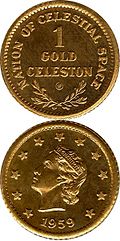 Despite these efforts, the Nation of Celestial Space is thought to have become defunct with the death of its founder. Its only surviving legacy is the series of stamps and silver and gold coins and passports issued in its name by Mangan from the late 1950s through to the mid 1960s.
Despite these efforts, the Nation of Celestial Space is thought to have become defunct with the death of its founder. Its only surviving legacy is the series of stamps and silver and gold coins and passports issued in its name by Mangan from the late 1950s through to the mid 1960s.
Some of the coins minted by Celestia included a silver "1 Joule" of 4.15 grams (.925 silver) and a gold "1 Celeston" of 2.20 grams (.900 gold). Their scarcity ensures that they sell for many hundreds of dollars apiece on the rare occasions they come to market.
en.wikipedia.org/wiki/Nation_of_Celestial_Space
